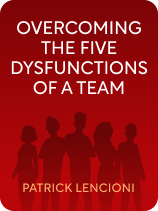

This article is an excerpt from the Shortform book guide to "Overcoming the Five Dysfunctions of a Team" by Patrick Lencioni. Shortform has the world's best summaries and analyses of books you should be reading.
Like this article? Sign up for a free trial here.
Do your team members know how to handle disagreements in a constructive way? Or, do they let conflict build up until it explodes?
In Overcoming the Five Dysfunctions of a Team, renowned business consultant Patrick Lencioni says that, once you’ve tackled Dysfunction #1 (the absence of trust), you can take on Dysfunction #2: a fear of conflict. When it’s managed well, conflict is healthy for teams.
Continue reading to learn Lencioni’s advice for mastering conflict in teams.
Mastering Conflict in Teams
Once your team trusts each other, they’ll be ready to start working through Lencioni’s second team dysfunction: a fear of conflict. In other words, now that your team members trust each other to act in good faith, you can teach them how to disagree with each other respectfully and productively.
(Shortform note: As Lencioni says, trust is crucial for mastering conflict because your team members need to understand that their teammates always have good intentions, even when arguments get heated. In Difficult Conversations, the authors describe a skill that supports this understanding: separating intent from impact. Team members should recognize that their teammates didn’t mean to make them feel hurt or uncomfortable, even if they ended up feeling that way. This is especially crucial because people often subconsciously associate bad intentions with bad people, and they’re far less willing to cooperate with someone whom they view as a bad person.)
Lencioni notes that, ideally, disagreements get a lot of different ideas out in the open so your team can thoroughly discuss them and choose the best option. That’s why mastering conflict in teams is crucial.
(Shortform note: Fostering productive healthy conflict arguably starts with carefully selecting who’s on the team in the first place. If you’re able to choose who’s on your team, try to include people from as many different backgrounds as possible. The more diversity your team members have in their upbringings, career paths, and skill sets, the wider range of perspectives they’ll bring to the table. In turn, those different perspectives will create more healthy conflict among the team.)
We’ll explain how to encourage healthy, constructive debates. Doing so first requires you to understand team members’ different styles of conflict—aggressive and argumentative versus calm and logical. It often also requires guidance from the team leader during discussions. Let’s look at each of these requirements in detail.
Understanding Styles of Conflict
Lencioni says that just like you do with building trust, you should begin the process of fostering healthy debates by helping your team members understand each other. Specifically, have a conversation with the team about how each of them approaches conflict.
For example, how comfortable are each of your team members with arguing? What tactics do they tend to use in arguments—passionate appeals to emotion, calm and logical arguments, or somewhere in between? What cultural and familial influences formed the foundations of their conflict styles?
Once you have an overall idea of how your team handles conflict, Lencioni says to establish what he calls conflict norms. Work with your team to set rules and expectations for debates—that way, they can handle conflict in a way that’s effective and comfortable for everyone.
| Be Aware of People-Pleasing Behavior While tackling Dysfunction #2, be aware of people-pleasers: people who are afraid of any kind of conflict and eagerly agree with everyone. People-pleasers also tend to burn themselves out by taking on every task that’s asked of them and taking blame for things that aren’t their fault. These qualities make them very likable but are unhelpful for a team that relies on honest discussion and debate. If you have people-pleasers on your team (or are one yourself), one conflict norm you might set is replacing “maybe” with “no.” People-pleasers will often avoid outright conflict and instead project uncertainty about an idea or a request. If one of your team members (or you) seems afraid to commit to something, ask whether they’re really not sure about it, or if they actually disagree. If it turns out that they do disagree, remind them of the ground rule that they should say “no” with confidence—remember, you’ve already created an environment of trust where it’s safe to do so. |
Guiding Healthy Conflict
Lencioni says that, even after you’ve established that conflict is expected and desired and have set your conflict ground rules, you’ll often have to encourage your team to start debates.
First, start team meetings by telling everyone what you’ll be discussing that day, why it’s important, and what the consequences will be if the team makes a bad decision. This will ensure that your teammates are engaged and energized right from the start.
(Shortform note: In his business parable Death By Meeting, Lencioni provides another tip to make sure your team gives it their all: Make the stakes personal. Don’t just talk about what the team’s decision will mean for the company in general—make sure they understand the impact it will have on them as individuals. For example, a good decision might lead to better profits for the company and therefore better bonuses for the team members.)
You might also need to help keep the discussion going. For example, if there’s a team member who tends to be quieter than the others, specifically ask for that person’s input from time to time. Lencioni also says that you should look for potential conflicts and try to bring them out into the open during meetings. If you suspect someone has an objection or argument that they’re holding back, encourage them to speak up.
Finally, Lencioni says that, although it’s important to encourage discussion and healthy conflict, a team leader also needs to know when to bring a debate to an end. Your team will often be unable to reach a consensus; if the conversation seems to be going in circles or tempers are wearing thin, it’s time for the team leader to step in and make a final decision.
| How to Be an Effective Moderator In essence, Lencioni is saying that the team leader should act as a moderator during team meetings—someone who guides the debate and keeps people from going off-topic. As such, here are some tips to effectively moderate a discussion. 1) Minimize your speaking time. It’s difficult to both act as a moderator and be a part of the discussion because you won’t have anyone to moderate you. Therefore, try to make a point of speaking only when necessary and for as short a time as possible. As Lencioni says, this could mean simply encouraging others to share their concerns and conflicts in order to promote productive conflicts. 2) Allow time for discussion. Remember, the purpose of having a team isn’t just to present ideas—it’s to discuss them. Therefore, make sure to leave plenty of time for people to think about what they’ve heard, ask questions, and debate each other’s ideas. You can do this by having “discussion time” as early as possible in the meeting and saving updates or presentations for the end, where they can be cut and sent via email if you need extra time for debates. 3) Keep the meeting on schedule. You’ve got a limited amount of time for any given meeting. Therefore, set a time limit for how long any one person is allowed to speak or how long the team can spend discussing a particular topic. As a moderator, it will be your job to watch the time and keep things moving along as needed. If a topic is running over time, you might need to stop the debate and come back to it during another meeting, or make a final decision yourself so that the team can move on (as Lencioni notes). |

———End of Preview———
Like what you just read? Read the rest of the world's best book summary and analysis of Patrick Lencioni's "Overcoming the Five Dysfunctions of a Team" at Shortform.
Here's what you'll find in our full Overcoming the Five Dysfunctions of a Team summary:
- What "teamwork" actually means, and how to foster it
- Why trust is the most important element in an effective team
- The five impairments to teamwork and how to overcome them






